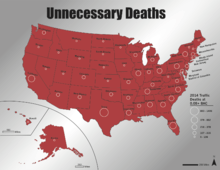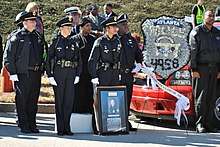Alcohol-related traffic crashes in the United States
Alcohol-related traffic crashes are defined by the United States National Highway Traffic Safety Administration (NHTSA) as alcohol-related if either a driver or a non-motorist had a measurable or estimated BAC of 0.01 g/dl or above.[2]

This statistic includes any and all vehicular (including bicycle and motorcycle) accidents in which any alcohol has been consumed, or believed to have been consumed, by the driver, a passenger or a pedestrian associated with the accident. Thus, if a person who has consumed alcohol and has stopped for a red light is rear-ended by a completely sober but inattentive driver, the accident is listed as alcohol-related, although alcohol had nothing to do with causing the accident. Furthermore, if a sober motorist hits a drunk pedestrian, the accident is also listed as alcohol-related. Alcohol-related accidents are often mistakenly confused with alcohol-caused accidents. Some[3] have criticized the NHTSA for compiling this statistic since it may give the impression that drunk drivers cause a much higher percentage of accidents and does not accurately reflect the problem of drunk driving in the United States.

Nationally, 12.8% of all drivers involved in fatal accidents during 2013 are known to have been intoxicated according to the blood alcohol concentration (BAC laws) of their state. This number is based on a systematic examination of the official records of each and every accident involving a fatality during that year in the US. However, a majority of fatalities resulting from car accidents involving alcohol are from sober drivers who are hit by drunk drivers.
The higher number (about 40%) commonly reported refers to accidents defined as alcohol-related as estimated by the National Highway Traffic Safety Administration.
Each year, The Century Council, a national non-profit organization funded by a group of alcohol manufacturers, compiles a document of alcohol-related traffic fatalities. Between 1991 and 2013, the rate of alcohol-related traffic fatalities (ARTF) per 100,000 population has decreased 52% nationally, and 79% among youth under 21.[5]
NHTSA data
According to NHTSA, all states of the U.S.A. including district of columbia and puerto rico have a bac limit of 0.08 g/dL or lower.
In 2016, in the USA, 10,497 people were killed in a fatal crash involving an alcohol impaired driver. 62% of the people killed in such a crash were drivers, 29% occupants, and 9% non occupants.[6]
This data is described as
Total includes fatalities in crashes in which there was no driver (includes motorcycle riders) present.
The 10,497 killed in fatal crash involving an alcohol impaired driver makes 28% of the fatalities. When considering BAC greater than 0.15 g/dL, 7,052 people were killed (19%), while for a BAC greater than 0.01 g/dL, 33% have been killed.[6]
In 2016, the best countries with the less alcohol impaired driver involved in fatal crash were Utah and Mississippi, 128 and 52 killed (19%).[6]
75% of the drivers with BAC levels of 0.08% or higher involved in fatal crashes are aged between 21 and 44.[7]
25% of the motorcyclists killed in fatal crashes had BACs of 0.08% or greater.[7]
See also
- Foundation for Advancing Alcohol Responsibility, funded by a group of distillers
- Mothers Against Drunk Driving
- Transportation safety in the United States
References
- "Stats". crashstats.nhtsa.dot.gov. Retrieved 2019-07-30.
- "Alcohol Involvement in Fatal Crashes, Comparison Among Countries - Background and Introduction - DOT HS 809 355". one.nhtsa.gov.
- "National Motorists Association - Driver Advocacy". National Motorists Association.
- "Senior Police Officer Gail Denise Thomas". The Officer Down Memorial Page (ODMP).
- "The Century Council's Research". Archived from the original on 2008-07-15. Retrieved 2008-06-24.
- https://crashstats.nhtsa.dot.gov/Api/Public/ViewPublication/812450
- "Impaired Driving: Get the Facts | Motor Vehicle Safety | CDC Injury Center". www.cdc.gov. March 28, 2019.